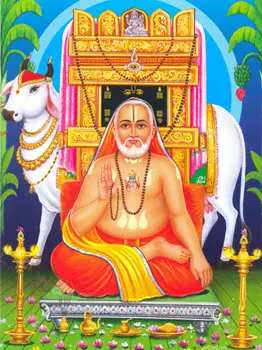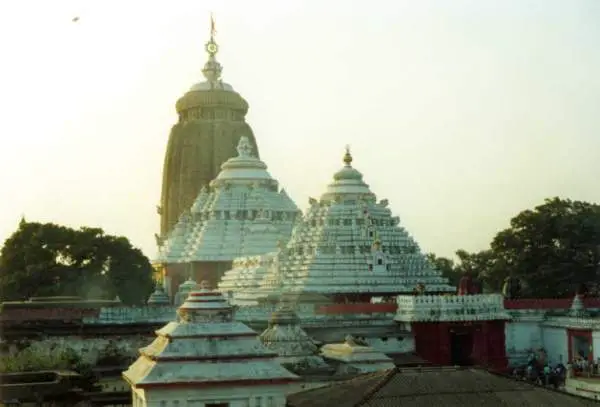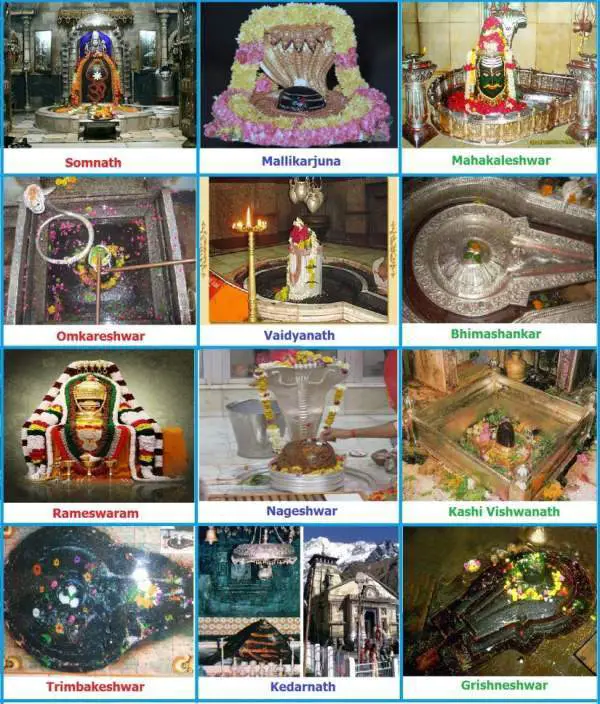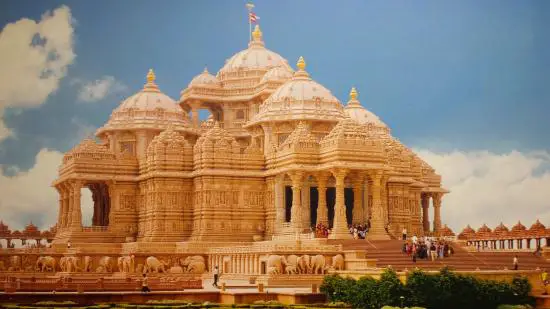The Mantralayam Temple has been dedicated to Sri Guru Raghavendra Swamy (c.1595–c.1671), who was a Hindu scholar, theologian, and saint.
This temple treasures the memorial of this famous Vaishnava saint, Sri Raghavendra.
This temple is located in Mantralaya in the Kurnool district of Andhra Pradesh along the banks of River Tungabhadra.
This guide features Mantralayam Temple History & Timing along with other important details, as well.
Table of Contents
About Sri Guru Raghavendra Swamy
Sri Guru Raghavendra Swamy was a renowned Hindu saint and philosopher who lived between 1595 and 1671 CE. He is considered as an incarnation of Bhakta Prahlad, who was saved by Lord Vishnu in his Narasimha Avatar.
Sri Raghavendra Swamy was born as Sri Venkata Natha, the second son of Sri Thimanna Bhatta and Smt. Gopikamba on the Shukla Navami Tithi (Thursday) of Phalguna month in 1595 at Bhuvanagiri near present-day Chidambaram in Tamil Nadu.
He was a very brilliant scholar from a very young age. He was also very proficient at playing Veena. He was married to Saraswathi Bai in the year 1614. He had a son Sri Lakshminarayanacharya.
Sri Raghavendra Swamy learned Dwaita Vedanta, Grammar, and other literary works under his guru, Sri Sudheendra Theertha. He was well versed in Bhashyas and usually participated in debates against renowned and reputed scholars.

Sri Raghavendra Swamy was an ardent devotee of Sri Panchamukha Mukhya Prana Devaru (the five-faced form of Lord Hanuman).
He spent a major portion of his life teaching Sanskrit and other Vedic texts to children. He never took money for his services and lived a life of poverty along with his wife and son. They had to go without food several times a week.
Sri Raghavendra Swamy is known to have performed many miracles during his lifetime. Once, he was invited to attend a function when he was touring Kumbakonam. However, the hosts did not treat him well. They wanted him to make some sandalwood paste for all the invitees.
As per his habit, Sri Raghavendra Swamy was chanting mantras and Stotras while preparing the sandalwood for Tilak. The guests applied this paste on their bodies, it induced a burning sensation all over their bodies. All the guests were surprised at this and asked for clarification from him.
Sri Raghavendra Swamy replied that the burning sensation was because of the Agni Suktam (hymn defined in the Vedas) that he was chanting when preparing the sandalwood for the guests.
So, the eternal power of this Vedic Mantra revealed itself in the form of burning sensation all over their bodies. It happened because the Vedic Hymn (Mantra) was chanted with absolute dedication and devotion by the Guru himself, who was completely devoted to Lord Hari.
Now, the host realized his devotion and power and apologized profusely to Sri Raghavendra Swamy.
Sri Guru Swamiji spent his entire life in the worship of God as well as the service of humanity. He took Sannyas in 1621 on the Phalguni Shukla Dwitiya at Tanjore. He was appointed to be the successor of the Mathh at Mantralayam by his Guru Sri Sudheendra Theertharu.
His Holiness took on an extensive tour of South India for spreading the Dvaita philosophy. He visited many famous pilgrimage centers like those at Rameshwaram and Srirangam.
At Rameshwaram, Sri Raghavendra Swamy clarified the origins of the Shiva Lingam. He said that the Shiva Lingam here was installed by Lord Rama himself before he moved on to Lanka to fight Ravana.
He rebuffed the statements of some scholars that stated that Lord Rama, as the Supreme God, is not bounded by Brahma Hatya Dosha for killing Ravana.
He also traveled to many other places, including Kanyakumari, Madurai, and Thiruvananthapuram. He visited many spiritual centers such as Vishnu Mangala, Kukke Subramanya, and Udupi in Karnataka, impressing one and all by his mastery of Dvaita philosophy.
Sri Guru Raghavendra performed penance at Panchamukhi, near Mantralayam, where he received Darshan of Lord Hanuman in the form of Sri Panchamukha Mukhya Prana.
He chooses Mantralayam as the location of his Brindavana (Jeeva Samadhi) because it was the region where King Prahlad performed the Yagna to Lord Rama during the Dwapara Yuga and hence was regarded as an extremely holy land.
Sri Guru entered into Jeeva Samadhi on the Dwitiya of Sravana Krishna Paksha in 1671. The Raghavendra Mattha in Mantralayam, which houses his Brindavana, is visited by thousands of devotees each year.
Mantralayam Temple History
The Mantralayam Temple in Andra Pradesh is dedicated to Sri Guru Raghavendra Swamy. It carries the Jeeva Samadhi known as “Brindavana” of Sri Guru Raghavendra Swamy, who lived during the 16th century. He is known as the incarnation of Lord Vishnu Bhakta – Prahlad.
Sri Raghavendra was an ardent devotee of Sri Moola Rama and Sri Panchamukhi Mukhya Prana Devaru. It is believed that Sri Guru saw Lord Hanuman when he was performing penance at Panchamukhi. Sri Raghavendra extensively preached Dvaita philosophy as well as the teachings of Madhavacharya.
Before becoming a saint, Sri Guru was a family man with a wife and a son. On the day of his Sannyas (transformation), his wife wished to see him for the last time. She came running to the Mutha, but fell in an abandoned well and died.
Due to her untimely death, her desires were not fulfilled, and she became a ghost. She came to see the saint in the Mutha. However, Sri Guru sensed her presence and sprinkled holy water from his Kamandalu, relieving her from the Preta Yoni. Sri Raghavendra is also known for performing many miracles in his lifetime.
There is an interesting story connected with the Mantralayam Temple. Once it so happened that Sri Guru got an opportunity to meet the Nawab of Adoni face-to-face.
However, instead of paying respect to the saint, the Nawab tried to test his spiritual skills. So, he placed a plate full of non-vegetarian delicacies before Swamiji and covered it with a piece of cloth in the guise to offer alms.
As per the Hindu traditions, it is customary to offer alms when you visit a saint to seek his blessings.
Swamiji, as per his regular practice of purifying any food before consumption, meditated and sprinkled some water from his Kamandalu on the covered plate.
Now, he opened the plate. He saw that the plate contained fresh fruits. When Nawab saw all this, he immediately became remorseful and apologized before Swamiji. He became an ardent devotee of Sri Guru Raghavendra Swamy.
Nawab told Swamiji that he is willing to give any amount of wealth and land that Swamiji wants. However, Swamiji refused any such gifts for his personal gains. However, Nawab insisted on giving Swamiji wealth and land.
So, Swamiji asked Nawab to hand over the dry and barren region around Mantralayam (on the banks of River Tungabhadra) to this Matha. The Nawab willingly agreed to this and handed over that piece of land to Swamiji.
Many years later, Swamiji told his devotees that it was the same region where King Prahlad had performed his Yagna to Lord Rama during the Dwapara Yuga. Hence, it is regarded as an extremely holy land.
Swamiji moved his Matha to Mantralayam, where he continued his spiritual journey. It is the same place where the Mantralayam Temple has been built.
At Mantralayam, Sri Guru encouraged the custom of Annadana (donation of food), which is a practice followed to date by the Matha and is heavily subsidized by donations.
The Mantralayam Temple is not only a memorial of Saint Sri Guru Raghavendra Swamy but is also worshiped Lord Hari, Vayu, as well as Rayaru. It houses three spectacular chariots that are made with sandalwood and have been adorned with fresh and bright flowers. As per the religious customs, the deities are placed on the chariots, and the procession is taken around the temple.
Mantralayam Temple Timings
The general timing at the Mantralayam Temple is from 6 am to 8 pm. Here, we have provided an elaborate break up of Mantralayam Temple timings:
- Morning Darshan: 06:00 am to 02:00 pm
- Evening Darshan: 04:00 pm to 09:00 pm
- Tirtha Prasad (Food): 01:00 pm to 03:00 pm
- Swamiji Darshan: 06:30 pm to 08:30 pm
- Seva Sankalp: 08:00 am to 09:00 am
Note:
- Mahapooja to Moola Rama, Mukhya Prana as well as Brindavana is being performed at noon
- Mantrashakta lasts from 10:00 am to 11:30 am
Mantralayam Temple Dress Code
According to the Mantralayam Temple Dress Code, men need to wear dhoti and no shirt (only Angavastram). Women have to wear a sari or salwar kameez. Devotees are not allowed to wear any informal attire, such as jeans, T-shirts, or shorts.
Last but not least, devotees are expected to bath in the holy waters of the Tungabhadra River before performing puja at the temple.
How to reach
- By Air: The Hyderabad Airport is nearest to the temple at a distance of 236 kilometers from Mantralayam. Once you disembark the flight, you can rent cabs for reaching the temple.
- By Train: The Mantralayam Road is the nearest railway station to the Raghavendra Swamy Temple. It is about 12 kilometers from Mantralaya. It lies on the railway route of Mumbai-Chennai, Delhi-Bangalore, and Hyderabad-Tirupati.
It takes about an hour to reach the Mantralayam Temple from the railway station. Private Cabs, Auto Rickshaws, Vans, and Buses are available at the railway station, which can take you directly to the shrine. - By Road: Regular bus service is available from all the major South Indian cities such as Bangalore, Mysore, Chennai, Hyderabad, Tirupati, and Bellary.
So, that’s all in this post on Mantralayam Temple History & Timings. We hope you found the post informative and useful, as well. Thanks for visiting. We welcome your comments and suggestions. We request you to please share the post across major social network channels.





